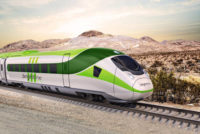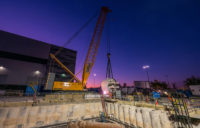The project team at Allegiant Stadium in Las Vegas has been running two races: first, a sprint to finish the $1.9-billion domed stadium in time for the NFL’s Raiders to play their first season in Las Vegas this fall, and second, staying a step ahead of the pandemic. Mortenson-McCarthy, the joint venture between M.A. Mortenson Co. and McCarthy Building Cos. that is serving as general contractor on the project, reports the 65,000-seat stadium remains on track for substantial completion in July, with the Raiders and University of Nevada Las Vegas football teams scheduled to play their first games there in August.
Allegiant Stadium, named for the Las Vegas-based airline, will be the biggest indoor venue in southern Nevada. The stadium will be available to host at least two-dozen non-football events a year, starting with a Garth Brooks concert set for August.
At least 15 new active cases of coronavirus have emerged among workers after the Southern Nevada Health District conducted nearly 850 tests at the site in early June. That’s in addition to 16 workers on site who tested positive before May 1, SNHD says.
Other employees have missed work because they were sheltering in place or taking care of sick relatives, but work at the site never stopped, and absences haven’t been a major issue, Mortenson-McCarthy says. The joint venture team says it is meeting all regulatory protocols and has instituted widespread safety policies because of the pandemic, including a focus on cleanliness and requiring masks and social distancing on the jobsite, whenever possible.
Eric Grenz, project director and vice president for the joint venture, says the additional safeguards, engineering controls and CDC preventative measures have added to costs, but the stadium will come in on budget and on time.
Entertainment Landmark
The sleek 1.8-million-sq-ft stadium, encased in black glass, creates a new landmark at the south end of the city’s tourist corridor and just west of the Las Vegas Strip. It will offer amenities worthy of what’s been dubbed the Entertainment Capital of the World, starting with the scenery.
The stadium, which sits on a northeast-southwest axis, is fully enclosed, but fans can view the nearby Strip through a 90-ft by 200-ft opening when four 50-ft-wide glass-and-steel lanai doors are opened. Lucas Oil Stadium in Indianapolis and U.S. Bank Stadium in Minneapolis offer fans views of their respective downtowns through similar window and sliding door systems.
“It’s really the money shot, and the place to be in the stadium. It’s like opening the front door and having the Strip as your landscape,” Grenz says. “These are some of the largest operable features you’ll find anywhere.”
The Allegiant Stadium doors will remain open during events, except during the searing heat of a Las Vegas summer or when wind speeds top 25 mph. The Raiders also will be required to have weather monitoring stations in the vicinity for warnings in case of desert thunderstorms.
A 93-ft-tall eternal torch, a memorial to late Raiders owner Al Davis, will greet visitors inside the stadium. The torch, which will have a special-effect flame, was created using a 3D printer with 5,500 layers on 225 printed blocks. The Raiders are seeking its inclusion in the Guinness Book of World Records as the largest-ever 3D-printed structure by volume. The torch is surrounded by a circular bar that will be part of the 55,000-sq-ft Peristyle Club, one of nine clubs planned for the stadium. The stadium also will feature 10 event spaces, 127 suites, 8,000 club seats, 2,200 televisions and LED signs, and 1,700 WiFi access points.
“People will recognize this as part of the Las Vegas entertainment experience,” says Lanson Nichols, vice president of sports architecture for Kansas City, Mo.-based HNTB Corp., the architect of record for the project.
“Time is not a friend. You have to be wise in the early decisions you make.”
– Lanson Nichols, VP of Sports Architecture, HNTB Corp.
The project, which is being built with all union labor, is topped by a 7-acre ethylene tetrafluoroethylene (ETFE) roof that designers say will give fans an outdoor feel but with an indoor, climate-controlled setting. A cable net truss system of 100 stainless steel cables creates the diaphragm of the roof structure.
To date, construction has required more than 125,000 cu yd of concrete and 28,000 tons of structural steel.
Crews encountered the project’s most significant construction setback in October when a subcontractor was jacking and tensioning the cable net system and a compression ring splice plate connection failed. The erection and tensioning of the cable net system needed to be done in a way to prevent connections on the ring beam from being overstressed.
After more than 10 weeks of study and planning, lift operations resumed without a hitch. The delay required what Grenz calls “an all hands-on deck approach to finish the ETFE roof” and protect the interior from the elements.
“Although we experienced the splice plate connection failure, the cable net truss system looks stunning,” he says.
If the airy ETFE roof and gigantic window facing the Strip weren’t enough of an outdoor feel, fans can watch the players get real grass stains on their uniforms.
Allegiant Stadium will have an artificial surface for the UNLV Rebels, but the Raiders will play on a grass field that’s retracted when not in use. It’s the second stadium in the country with such a system and one of just a few in the world.
“That was Mr. Davis’ commitment,” says stadium designer Nichols of current Raiders’ owner Mark Davis, son of Al Davis. “He’s a football purist, and football must be played on grass.”
The natural turf field will be kept within a 400-ft by 220-ft tray that weighs 10,000 tons when filled with soil and grass. Moving it 800 ft to the outside of the stadium, where the grass can grow under the desert sun, requires 540 wheels powered by 72 electric motors. The trip will take 71 minutes, giving the tray an average speed of 11 ft 3 in. per minute.
Along with the opening for the turf tray, the stadium’s big bay doors will allow trucks direct access to the field to deliver and remove equipment.
“Event changeover is everything in any arena. That’s what makes you competitive in the trade-show businesses,” says Nichols, who envisions the space also being used for trade shows and product launches.
Vegas Speed
The stadium broke ground in November 2017 and came together at “Vegas speed,” says Tommy White, business manager of Laborers’ International Union Local 872 in Las Vegas. His members installed the field tray and performed much of the other work, including roofing installation, concrete placement, laying of pavers, landscaping, sanitization, underground utility installation and blasting down 30 ft for the foundation.
“We built one of the best-looking stadiums in a short period of time,” White says.
The compressed schedule—less than three years from start to completion—was seen by many as the biggest challenge the team faced. “Time is not a friend. You have to be wise in the early decisions you make,” says Nichols, who has worked on other NFL stadiums and says Allegiant has had the tightest schedule. He credits design-build as the “only way you can achieve the schedule compression that was necessary.”
Grenz agrees, saying design-build was the “secret sauce” for the project. “There’s probably not another stadium out there that has been designed and built in the time it has taken us,” he says.
“It allowed us to work shoulder to shoulder with the designers and build a facility in lockstep with the budget and the schedule.”
As of early June, workers had logged more than 5.8 million hours, with the workforce averaging about 2,200 people during peak construction. The project’s OSHA recordable incident rate is 1.1, compared with a national average of more than 3.0.
Nearly 25% of all work awarded on the project has gone to small businesses. That beats the goal of 15% that was set after state and local officials agreed to contribute $750 million in public funding toward construction. The joint venture reports that workforce utilization for minority- and women-owned (MBE) firms has reached 62%, compared with the initial goal of 38%.
“We know that the success of each of our projects is directly linked to those efforts and partnerships with minority-owned, woman-owned and small businesses,” Grenz says.
Grenz has worked on college and pro stadiums and arenas for most of his career, but he says he will remember Allegiant Stadium as an opportunity to overcome “the incredible obstacles put in our way,” from early steel supply chain issues to challenges with the cable net truss system to the ongoing COVID-19 pandemic.
“Getting to work on a project of this size and complexity through times of adversity, ambiguity and unchartered territories has been tremendous,” he says.









Post a comment to this article
Report Abusive Comment